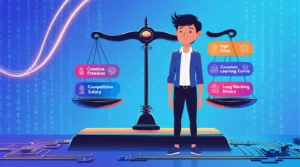Why Minimalist Web Design is the Future of Digital Experiences
In an era where digital experiences shape consumer behavior, web design has evolved significantly to meet changing user expectations. One of the most notable shifts in recent years is the rise of minimalist web design-a design philosophy that prioritizes simplicity, clarity, and usability. This approach strips away unnecessary elements, focusing only on what truly matters, resulting in cleaner, more efficient, and aesthetically pleasing websites.
Jump to
ToggleBut why is minimalist web design gaining so much traction? Why are top brands, designers, and businesses embracing simplicity over cluttered, feature-heavy websites? In this article, we’ll explore the core principles of minimalist web design, its benefits, real-world examples, and how you can implement it effectively.
What is Minimalist Web Design?
Minimalist web design is based on the idea that less is more. It eliminates distractions and unnecessary elements to create a seamless, focused user experience. It relies on the following key principles:
- Simplicity – Removing non-essential elements to create a clean, distraction-free design.
- Whitespace (Negative Space) – Using empty spaces effectively to enhance readability and user focus.
- Limited Color Palette – Utilizing a minimal range of colors for a visually cohesive experience.
- Clear Typography – Prioritizing readability with clean, easy-to-read fonts.
- Strong Visual Hierarchy – Guiding users’ attention to the most important elements.
- Fast Load Times – Reducing unnecessary scripts, animations, and large files to improve performance.
Minimalism in web design doesn’t mean dull or boring; rather, it’s about intentionality—ensuring that every element serves a purpose.
Why is Minimalist Web Design So Popular?
1. Improved User Experience (UX)
Modern users expect fast, intuitive, and seamless online experiences. A cluttered website with excessive buttons, pop-ups, and animations can overwhelm visitors, leading to frustration and higher bounce rates.
A minimalist design removes unnecessary distractions, ensuring visitors can quickly find what they need. Studies show that users form an opinion about a website within 50 milliseconds-meaning a clean, simple design can make an instant positive impression.
Example: Apple’s website is a perfect example of minimalist UX. With ample whitespace, simple navigation, and a focus on product visuals, users can easily browse and absorb information without distraction.
2. Faster Load Times
Page speed is a crucial ranking factor for search engines and directly affects user satisfaction. A heavy, cluttered website filled with excessive images, scripts, and animations can significantly slow down loading times.
Minimalist web design removes unnecessary elements, leading to:
- Faster page loads
- Better SEO performance
- Lower bounce rates
Statistic: According to Google, 53% of mobile users abandon a site if it takes longer than 3 seconds to load. By adopting minimalist principles, businesses can ensure their websites load quickly, retaining more visitors.
3. Mobile-First Design Compatibility
With mobile traffic surpassing desktop usage, designing with mobile users in mind is no longer optional. Minimalist web design naturally lends itself to mobile-first design because:
- Fewer elements mean better responsiveness
- Simpler layouts adjust seamlessly to different screen sizes
- Reduced reliance on heavy media improves mobile performance
Google’s mobile-first indexing also means websites optimized for mobile will rank higher in search results, making minimalism a strategic choice for businesses looking to improve visibility.
4. Stronger Branding and Visual Identity
A clean, minimal design allows brands to communicate their identity more effectively. By using a limited color palette, strategic typography, and high-quality visuals, businesses can create a strong, memorable brand presence.
Example: Nike’s website embraces minimalism with bold imagery, concise copy, and simple navigation. This approach keeps the focus on the brand and its products, reinforcing its identity.
5. Better Conversion Rates
Minimalist websites tend to have higher conversion rates because they eliminate unnecessary distractions that might prevent users from taking action. When calls-to-action (CTAs) are clear and prominent, users are more likely to engage, whether it’s signing up for a newsletter, making a purchase, or filling out a contact form.
Case Study: A/B tests by ConversionXL found that simpler landing pages with fewer distractions led to higher conversion rates compared to complex designs with excessive content and options.
6. Enhanced SEO Performance
Search engines favor websites that offer a good user experience. Because minimalist design:
- Reduces page load times
- Improves mobile usability
- Enhances content readability
…it naturally leads to better search rankings.
Moreover, a clean layout allows search engine crawlers to index pages efficiently, further boosting visibility.
7. Timeless Aesthetic Appeal
Trends in web design change rapidly, but minimalism is timeless. Unlike flashy, trend-driven designs that quickly feel outdated, a well-executed minimalist design remains modern and relevant for years.
This longevity reduces the need for frequent redesigns, saving businesses both time and money.
How to Implement Minimalist Web Design Effectively
If you want to embrace minimalist web design for your website, consider these actionable steps:
1. Prioritize Content and Functionality
Identify the most essential elements on your site and remove anything unnecessary. Ask yourself:
- Does this element serve a purpose?
- Will removing it improve user experience?
The goal is to retain only what adds value.
2. Use Whitespace Strategically
Whitespace isn’t just empty space—it’s a design tool that improves readability, highlights key content, and enhances aesthetics.
A good example is Google’s homepage. With plenty of whitespace and just one search bar, it directs complete attention to its primary function.
3. Limit Your Color Palette
A minimalist design typically features 2-3 core colors, ensuring a visually cohesive look. Monochromatic and neutral tones work well, but bold accents can be used sparingly to highlight important elements.
4. Simplify Navigation
Complex menus with too many options can overwhelm users. Instead, aim for:
- A clear, intuitive navigation bar
- A logical menu structure
- A visible search function for easy accessibility
5. Optimize Typography for Readability
Choose clean, readable fonts that enhance user experience. Avoid overly decorative or small text, and ensure proper contrast between text and background for easy reading.
6. Use High-Quality Imagery Purposefully
Images should add value, not just decoration. Large, high-resolution visuals work best when they:
- Align with your brand
- Convey a message clearly
- Enhance the user experience
7. Ensure Mobile Responsiveness
A minimalist design should be responsive across all devices. Test your site on multiple screen sizes and use flexible layouts that adjust dynamically.
8. Test and Iterate
Minimalist design is about refinement. Conduct A/B testing, gather user feedback, and make continuous improvements based on performance data.
Final words
Minimalist web design isn’t just a passing trend-it’s a powerful approach that enhances user experience, improves website performance, and strengthens branding. By embracing simplicity, businesses can create cleaner, more effective websites that stand the test of time.
Whether you’re redesigning an existing site or building one from scratch, minimalism offers a winning formula: a seamless experience, improved engagement, and better conversion rates. In today’s fast-paced digital world, simplicity truly is the ultimate sophistication.
So, if you’re looking to elevate your web presence, perhaps it’s time to strip away the excess and embrace the beauty of minimalism. 🚀





